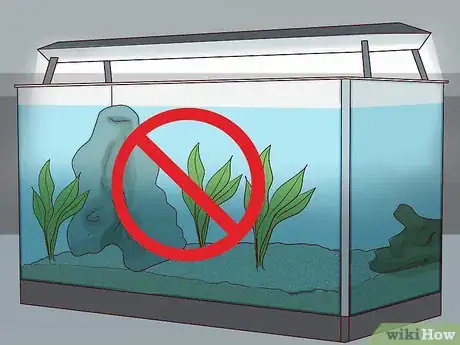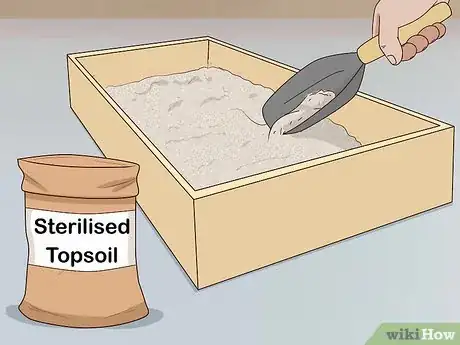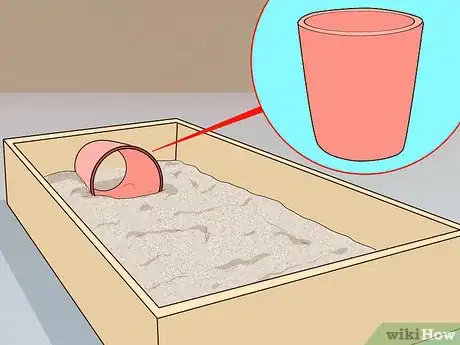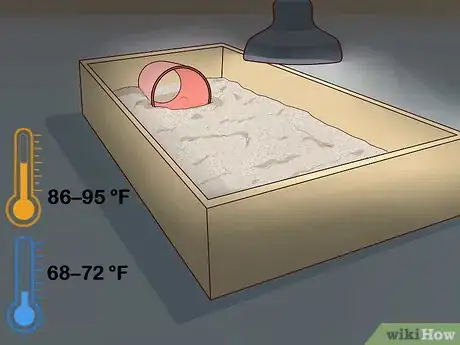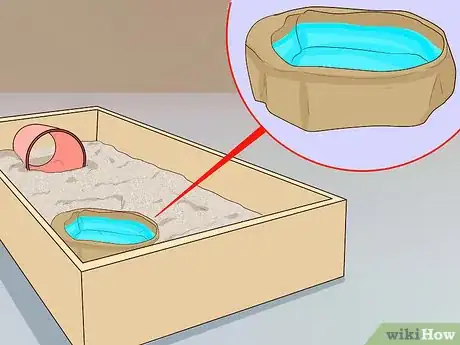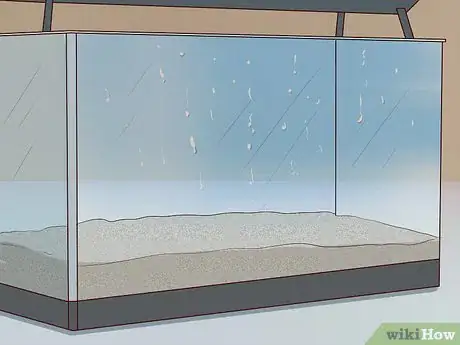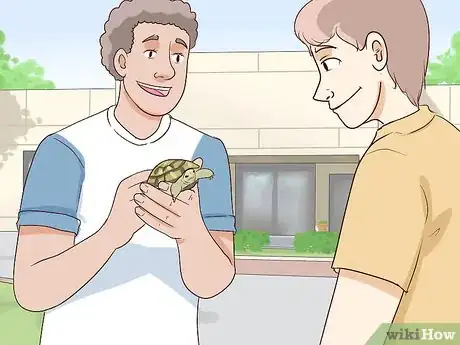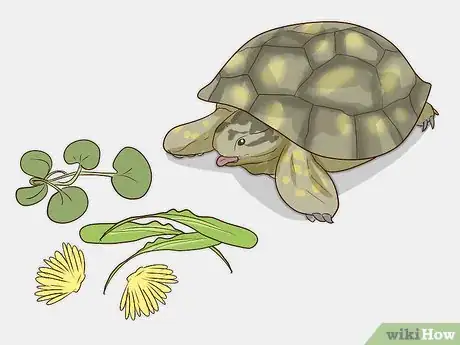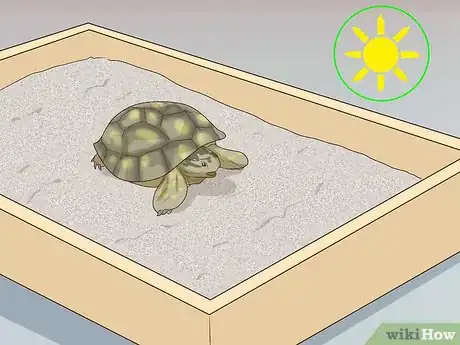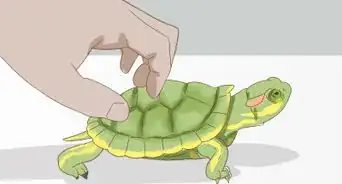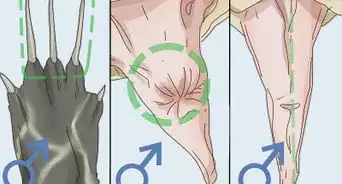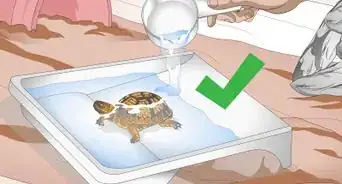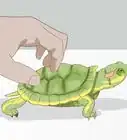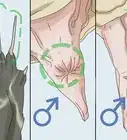wikiHow is a “wiki,” similar to Wikipedia, which means that many of our articles are co-written by multiple authors. To create this article, 29 people, some anonymous, worked to edit and improve it over time.
This article has been viewed 106,198 times.
Learn more...
Russian Tortoises make great pets. They're only about 6–8 inches (15.2–20.3 cm), making them a great beginner reptile. However, they can't be raised with ignorance, and with their long life, they need to be taken care of properly in the long run.
Steps
Housing
-
1Russian tortoises should not be housed in a vivarium or a fish tank as these do not provide correct ventilation. They also do not allow the tortoise to have a hot end, nor thermoregulate. The glass on the front of the cage/tank can stress your tortoise out as it cannot pass through. A wardrobe on its back and then supported is much better as it provides good ventilation and the sides are opaque, therefore the tortoise will not get stressed. The indoor enclosure should be at least 6 by 6 feet (1.8 m × 1.8 m). A UVB bulb (12%) can be used, as well as a 100/160 watt bulb. A combi bulb (heat bulb and UVB in one) can be used, which is perfect.[1]
-
2Place a layer of substrate down. A layer of sterilised topsoil is best, nothing else. Make sure the soil is deep enough to allow the tortoise to burrow and correctly thermoregulate. No other substrate is needed. No bedding such as hay, straw, aspen, etc.Advertisement
-
3Provide hiding places. 1 large plant pot is adequate for the whole enclosure. Make sure that this is placed in the cooler end of your table, as if placed in the warm end it will take up basking space and a tortoise would naturally find cooler places to hide and shelter.[2]
-
4Keep the basking area should be 30–35 °C (86–95 °F). The cool side should be around 20–22 °C (68–72 °F). The temperature everywhere in between doesn't matter as long as you have established the cool and warm sides.[3] You should have a good thermometer on both sides to accurately monitor the temperature.
-
5Provide a water dish that is deep enough for a tortoise to safely drink from. It needs to be a good size so that your tortoise can easily get inside of it and drink.
-
6Humidity is not vital for Russian species, despite common belief. People use humid hides for hatchlings. However, this isn't needed whatsoever as if the humidity is too high and it's too damp,it can cause RNS (Runny Nose Syndrome) which can be fatal and kill your new tortoise.[4]
General care of the tortoise
-
1Change the water in the table every day.[5]
-
2Feed the tortoise safe, edible weeds and flowers only. NO fruit or vegetables should be offered at all. Russian tortoises do not eat fruit or vegetables in the wild and are therefore adapted to purely eat weeds and flowers. Fruits and vegetables can upset gut flora and damage your tortoise in the long run, if the problems do not occur right away. Weeds should be sprinkled with limestone flour and nutrobal. Chalk or cuttlefish bone should be kept in the cage to provide calcium (from quarries etc).
-
3Tortoises should be kept outside in the summer months, if the weather permits. If the temperatures are above 15 °C (59 °F), it's warm enough for the tortoise to be outside. Tortoises should be brought inside if temperatures drop below 11°C. A safe, secure outside enclosure should be built. 6ft x 4ft would be adequate for one tortoise. Make sure no rats, foxes, dogs, cats, birds, etc. can enter, which could potentially kill your tortoise.[6]
Community Q&A
-
QuestionWhere can I buy the right lights?
 Community AnswerAny reptile dealer should stock the correct light bulbs.
Community AnswerAny reptile dealer should stock the correct light bulbs. -
QuestionMy parents agreed to let me get a tortoise. We are a military family and we move around every 3-5 years, I need a small tortoise that doesn't mind being handled. What can I do?
 Community AnswerRussian tortoises generally grow to be around 8-10 inches and can live for up to 50 years, but they are very easy to care for.
Community AnswerRussian tortoises generally grow to be around 8-10 inches and can live for up to 50 years, but they are very easy to care for. -
QuestionHow do I tell if the tortoise is male or female?
 Community AnswerYou can tell by looking at their tails. The males have longer tails (touch their hind legs) and spurs on their tail tips. You can find spur pictures through an image search. Once you see an example of one, it's pretty easy to sex yours.
Community AnswerYou can tell by looking at their tails. The males have longer tails (touch their hind legs) and spurs on their tail tips. You can find spur pictures through an image search. Once you see an example of one, it's pretty easy to sex yours.
References
- ↑ http://www.reptilesmagazine.com/Care-Sheets/Russian-Tortoise/
- ↑ http://www.reptilesmagazine.com/Turtles-Tortoises/Tortoise-Care/Russian-Tortoise-Care-Tips/
- ↑ http://www.reptilesmagazine.com/Turtles-Tortoises/Tortoise-Care/Russian-Tortoise-Care-Tips/
- ↑ https://www.tortoisetrust.org/articles/commondisease.html
- ↑ https://www.petmd.com/russian-tortoise-agrionemys-horsfieldii
- ↑ https://www.petmd.com/russian-tortoise-agrionemys-horsfieldii
About This Article
Russian tortoises make great pets as they’re relatively easy to care for. You’ll need an indoor enclosure that’s at least 6 by 6 feet. Use a combi bulb in the enclosure to provide heat and UVB to keep your pet healthy. Put a layer of sterilized topsoil on the floor of the enclosure, making sure it’s deep enough to let your tortoise burrow. You’ll also want to give your pet hiding places, like a large plant pot, and a water dish that’s deep enough for it to get into to drink. Change the water daily to keep your pet healthy, and give it safe, edible weeds and flowers to eat. To learn how to house your tortoise outdoors during the warmer months, keep reading!
